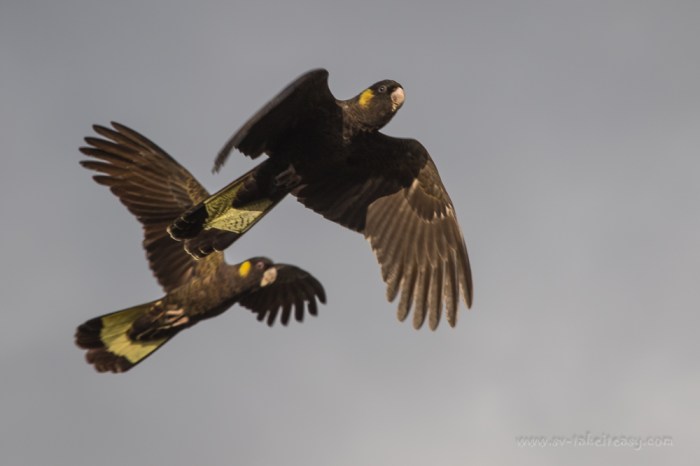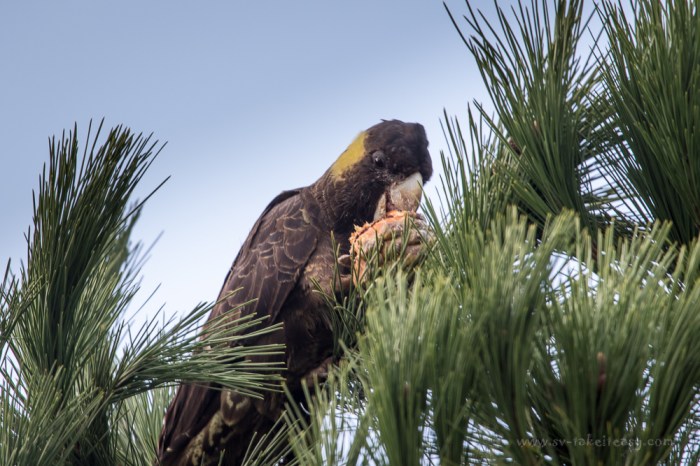You can hear it before you see it. It is a big parrot, dark at a distance, but with bright yellow markings as it gets close. It is the spectacular Yellow-tailed Black Cockatoo and the subject of our #43 Bird Photography Challenge.
What does it look like?

Pair in flight, showing their beautiful markings
The Yellow-tailed Black Cockatoo (Calyptorhynchus funereus) is a large parrot native to the South East of Australia. It measures 55 to 65 cm in length with a short crest on the top of its head. It has distinctive markings: its plumage is mostly black with yellow cheek patches and a pale yellow tail band. When seen up close the body feathers are edged with yellow, giving a scalloped appearance.
You can easily distinguish the genders; the female (on left) has a bone coloured beak and grey eye ring and a bright yellow cheek patch, and the adult male (on right) has a black beak, red eye ring and less prominent cheek patch.
In flight this cockatoo has deep slow wing beats and a loud eerie wailing call. You see them flying in pairs or trios, or even small family groups.
Did you know?
The genus Calyptorhynchus is derived from the Greek words Calyptos, “hidden”, and Rhynchos, meaning “beak”, a reference to their sturdy but stumpy bill. Funereus relates to its dark and sombre plumage, as if dressed for a funeral. The mood is definitely brightened when you see this beautiful cockatoo up close.
How does it behave?

Female feasting on a pine cone
Wood boring grubs and seeds are the favourite food of the Yellow-tailed Black Cockatoo. It prefers green cones from banksias, she-oaks and hakeas, but is also partial to pine cones as you can see in the photo. It nips the cone off at the stem and holds it in one foot, then systematically lifts each segment and extracts the seed. It keeps to the trees, only going to ground level to inspect fallen pine or banksia cones or to drink. The cockatoo is also fond of the larvae of tree boring beetles, gauging the larvae out and often damaging trees in the process. This does not endear it with orchard growers who see it as a pest when it descends on young trees, just like its cousin the Sulphur Crested Cockatoo.
This cockatoo nests in big isolated trees, mainly eucalyptus with large hollows, so it can fly to and from them unhindered. The hollows can be one to two meters deep with a base of wood chips and gum leaves. Two eggs are laid. The female incubates them while the male supplies her with food. Once hatched, chicks are looked after by both parents for up to six months, but typically only one chick survives.
Where is it found?
The Yellow-tailed Black Cockatoo is found in Central and Southern Queensland, New South Wales and into Victoria and South Australia. It frequents woodland, heathland and pine plantations. It is said that the average suitable tree for nesting is over 200 years old, which explains the increased scarcity of suitable habitat. This parrot is considered “secure” in most regions, although its numbers have reduced a lot. In the Eyre Peninsula (South Australia), it has been declared endangered.
The Yellow-tailed Black Cockatoos feed in small raucous and noisy flocks and often socialise before dusk, which is when we saw them recently. At Spermwhale Head in the Gippsland Lakes, there are a few pine trees and banksias on the point. We were moored at the jetty and could hear their raucous calls whenever they were there, feasting on the pine cones. They are weary birds, but if you approach slowly, they let you take their portrait while they are busy eating. However if one of them gets spooked, it gives a screeching alarm call and the flock takes off.
We have two galleries for you: one showing the Yellow-tailed Black Cockatoo in a mix of poses, the other as a flying sequence. The shots of the couple preening in the gum tree were taken with the Canon 60D. All other photographs were taken with the Canon 7Dii and the 100-400 mm lens, hand held. Click on any image in the galleries to display in full screen.
Flying sequence



















Beaut pictures Chris, one of my favourites since I discovered them while hiking at Mornington. We were wondering what was causing the distraction of the pines, with lots of cones on the floor. And then, there they were beautiful. My early day of loving birds and cemented my passion for these feathery creatures.
Yes they are raucous but beautiful parrots. Glad to have reminded you of your beginnings as a bird watcher!
excellent shots, Chris! Love the in-flight and the “lunch” pics most… apart from the cameras and lense, which other settings have you used?
Hi Hubert! With all bird photo, especially birds in flight I use AI Servo (Canon) AF-C (Nikon) – continuous refocusing to improve chances of clear shots. The rest of the settings are displayed in the meta data in the gallery.
thanks for the Nikon-info 😉 And I seem to have missed the detailed info in the gallery, will check again!
love these!! I love the one of the two flying!
They are quite spectacular, aren’t they!
yes!